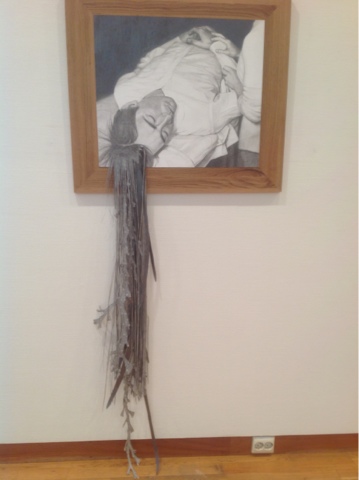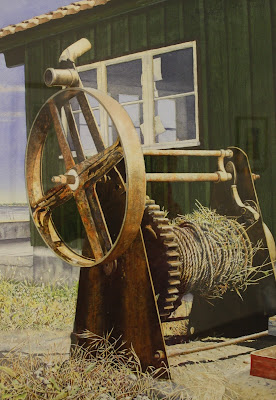Aujourd'hui il n'y avait rien en programme alors j'ai pris le dernier bateau à roues à aubes en service commerciale (pour la Poste) dans le monde entier Le voyage de Hamar jusqu'à Lillehammer, site des JO d'hiver en 1994, a duré pratiquement quatre heures.
Un roux à aube
Il ne faisait pas beau mais pour un anglais en août c'était pratiquement nostalgique.
Une marine (sic) remonte le drapeau après nous sommes passé en dessous un pont.
Le but était de visiter le musée de l'art à Lillehammer.
Pour l'été il y'a une expo' de peintres norvégiennes qui traverse plus que 150 ans.
15 June – 8 Sept
The historical section of the summer exhibition in Lillehammer Art Museum 2013 focuses on Kitty Kielland (1843–1914), Harriet Backer (1845–1932), Sigri Welhaven (1894–1991), Charlotte Wankel (1888–1969) and Ragnhild Keyser (1889–1943), artists who were prominent in Norwegian art history due to their originality and innovation. They were pioneers both in an artistic sense and as female forerunners in a male dominated field. The art canon is mainly written about men and by men.
The historical section of the summer exhibition in Lillehammer Art Museum 2013 focuses on Kitty Kielland (1843–1914), Harriet Backer (1845–1932), Sigri Welhaven (1894–1991), Charlotte Wankel (1888–1969) and Ragnhild Keyser (1889–1943), artists who were prominent in Norwegian art history due to their originality and innovation. They were pioneers both in an artistic sense and as female forerunners in a male dominated field. The art canon is mainly written about men and by men.
Academia, the historical account of exhibitions and purchases in institutional museums, the private collections, the art public, critique and publishing – the unbalanced access to the art institution is contained in the writing of history and is clearly reflected in women being underrepresented in the canon of art history. Of course, the activity of painting was part of the educational ideal for the female bourgeoisie but was not a choice of profession. Women of that time had limited access to normal academic education and the artistic identity was founded on Romanticism’s concept of the male artistic genius. Despite such circumstances, these women were able to live an artist’s life which has been important for the development of Norwegian art history.
Since the work of the female pioneers of the 1800s and early 1900s, the terms for being an artist have changed significantly by keeping apace with the changes of the woman’s role, but the statistical imbalance speaks clearly for itself. In addition to bringing into the open the artistic pioneering work of the female forerunners, this exhibition aims to cast light on the structural challenges and the mental barriers which female artists are confronted by in the current art scene. By allowing three Norwegian artists to have a dialog with the female forerunners, various themes of this axis are highlighted.
Both Kitty Kielland and Harriet Backer are today widely known artists’ names. They made their mark as independent and original artists within the Realistic and New Romantic traditions during the last twenty years of the 19th century. They were part of the golden age in Norwegian painting, a time during which the quality of Norwegian art was so high that it received international acclaim. Backer had her debut in the “Salon” in Paris in 1880, the leading place to be exhibited during that time. She received a silver medal at the World Exposition in 1889 and from 1921 received an artist’s salary from the Norwegian state – in total a recognition of her artistic endeavors. Both Backer and Kielland lived active artistic and intellectual lives. They were both champions of women’s liberation and particularly Kielland was an avid participant in the official debate about art and women’s liberation. In 1884 Kielland founded Norsk Kvinnesaksforening (The Norwegian Organization for Women’s Liberation) and for a number of years Backer had a painting school (1890 – 1920), in the later years primarily for women. It was symptomatic that both remained single. The role of an artist was incompatible with the role of wife and mother. Although Backer painted interiors, they both moved away from the typical “female” motifs such as portraits and family pictures, floral still lifes and cultivated park-like landscapes.
Both Kitty Kielland and Harriet Backer are today widely known artists’ names. They made their mark as independent and original artists within the Realistic and New Romantic traditions during the last twenty years of the 19th century. They were part of the golden age in Norwegian painting, a time during which the quality of Norwegian art was so high that it received international acclaim. Backer had her debut in the “Salon” in Paris in 1880, the leading place to be exhibited during that time. She received a silver medal at the World Exposition in 1889 and from 1921 received an artist’s salary from the Norwegian state – in total a recognition of her artistic endeavors. Both Backer and Kielland lived active artistic and intellectual lives. They were both champions of women’s liberation and particularly Kielland was an avid participant in the official debate about art and women’s liberation. In 1884 Kielland founded Norsk Kvinnesaksforening (The Norwegian Organization for Women’s Liberation) and for a number of years Backer had a painting school (1890 – 1920), in the later years primarily for women. It was symptomatic that both remained single. The role of an artist was incompatible with the role of wife and mother. Although Backer painted interiors, they both moved away from the typical “female” motifs such as portraits and family pictures, floral still lifes and cultivated park-like landscapes.
Kitty Kielland was Norway’s first female landscape painter, and can furthermore be characterized as a local painter. It was the open but windswept and flat landscape of Jæren which became her trademark. She had a series of motifs in common with Eilif Peterssen, but Kielland cultivates and perfects them in an independent manner. The magnificent landscape but with a close proximity to a detailed foreground gives her paintings an original interpretation. Kielland participated twice in the “Salon” in Paris – 1879 and 1880, and she was represented in the World Exposition in Paris in 1900.
Harriet Backer specialized in the interiors of churches and of farmhouses in Brittany and Norway. The specifics of location were of secondary importance. Composition, brush strokes and light were important elements for her. She combined new tendencies, the French open-air painting and Impressionism’s view on the treatment of color with a solid knowledge of classical composition which made her an unrivalled colorist. Backer placed the formal treatment of a motif side by side with theme.
Sigri Welhaven, Charlotte Wankel and Ragnhild Keyser have a common trait: they made a name for themselves in the 1920s, but despite receiving recognition in the international art scene at Montparnasse (in Paris), they did not receive the same recognition in Norway as Kielland and Backer had been given in the previous generation.
Sigri Welhaven lived in Paris during the years 1919 – 1939 and made her mark there in the international milieu for sculptors. She worked with torsos and portraits and developed a sureness of style and independence in her simplified expression. She received permanent right to exhibit in the Salon d’autonome after participating there with a bust of the French fauvist painter, Othon Friesz. Her style was inspired by Rodin and she worked with the goal in mind to simplify sculptures in such a way that the detail was subordinate to the exact whole. Parallel with the sculptures in bronze, she worked with faience, an old French method, where the expression was more exuberant and playful than with the works in bronze. Incidentally Welhaven was a niece of Harriet Backer and her sister was the painter Astri Welhaven Heiberg. It is interesting that both Charlotte Wankel and Ragnhild Keyser were students at Harriet Backer’s painting school in Kristiania, Wankel from 1906 to 1909 and Keyser from 1909 to 1910. Both studied at Acadèmie Moderne under Ferdinand Lèger in the 1920s and after a while they belonged to the real avantgarde in Paris. During the 1920s Wankel was greatly inspired by le Corbusier’s ideas about architecture and painting which actually led to plan-cubism and puritanical painting. While Wankel combined realistic elements with precise geometric shapes, Keyser’s work from this period is completely non-figurative. Earlier Keyser had studied under Andrè Lhote and was influenced by his half-cubistic interpretation of landscape. From there her work led her into the fundamental principles of modernism. In Norway both Wankel and Keyser were received with little understanding from the critics and the public with spending power. After their return from Paris, the two women adjusted to the Norwegian market but not without bitterness and at the expense of a further development of the modernistic style with which they had made a name for themselves internationally.
Sigri Welhaven lived in Paris during the years 1919 – 1939 and made her mark there in the international milieu for sculptors. She worked with torsos and portraits and developed a sureness of style and independence in her simplified expression. She received permanent right to exhibit in the Salon d’autonome after participating there with a bust of the French fauvist painter, Othon Friesz. Her style was inspired by Rodin and she worked with the goal in mind to simplify sculptures in such a way that the detail was subordinate to the exact whole. Parallel with the sculptures in bronze, she worked with faience, an old French method, where the expression was more exuberant and playful than with the works in bronze. Incidentally Welhaven was a niece of Harriet Backer and her sister was the painter Astri Welhaven Heiberg. It is interesting that both Charlotte Wankel and Ragnhild Keyser were students at Harriet Backer’s painting school in Kristiania, Wankel from 1906 to 1909 and Keyser from 1909 to 1910. Both studied at Acadèmie Moderne under Ferdinand Lèger in the 1920s and after a while they belonged to the real avantgarde in Paris. During the 1920s Wankel was greatly inspired by le Corbusier’s ideas about architecture and painting which actually led to plan-cubism and puritanical painting. While Wankel combined realistic elements with precise geometric shapes, Keyser’s work from this period is completely non-figurative. Earlier Keyser had studied under Andrè Lhote and was influenced by his half-cubistic interpretation of landscape. From there her work led her into the fundamental principles of modernism. In Norway both Wankel and Keyser were received with little understanding from the critics and the public with spending power. After their return from Paris, the two women adjusted to the Norwegian market but not without bitterness and at the expense of a further development of the modernistic style with which they had made a name for themselves internationally.
Kitty Kielland (1843-1914)
Charlotte Wankel (1888-1969)
Vanna Bowles (né 1974)

































































